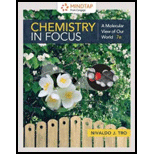
Concept explainers
Interpretation:
The reason for the fact that soaps and detergents are called surfactants is to be explained.
Concept Introduction:
Surface tension is the tendency of a fluid surface due to which it obtains the least surface area. Surface tension refers to the tendency of a fluid surface which makes it acquire the least possible surface area. At liquid-air interfaces, surface tension results from the greater attraction of liquid molecules to each other (cohesion) than to the molecules in the air (adhesion).
A surfactant is used to decrease the surface tension in various phenomena. Because of surface tension, surfactants are called surface-active agents. Surfactants are compounds that lower the surface tension (or interfacial tension) between two liquids, between a gas and a liquid, or between a liquid and a solid. Surfactants may act as detergents, wetting agents, emulsifiers, foaming agents, and dispersants.
Want to see the full answer?
Check out a sample textbook solution
Chapter 15 Solutions
Owlv2 With Mindtap Reader, 1 Term (6 Months) Printed Access Card For Tro's Chemistry In Focus: A Molecular View Of Our World, 7th
- A vial of Xe 133 gas (t 1/2 = 5.24 d) os ca;obrated fpr 22mCi @ 6:00am on March 1. What is its activity at 6:00 pm on march 8? what is mCI remainarrow_forwardMcLafferty Rearrangement: Label alpha (), beta (), and gamma () on the molecule. Draw mechanismarrows to describe the process of the rearrangement. What functional group is lost during the rearrangement? What new functional group is made from the ketone/aldehyde you started with? What stabilizing chemical theory causes (allows) rearrangement to happen?arrow_forwardDon't used hand raiting and don't used Ai solutionarrow_forward
- Don't used hand raitingarrow_forwardIf a high molecular weight linear polyethylene is chlorinated by inducing the substitution of chlorine atoms by hydrogen, if 5% of all hydrogen atoms are replaced, what approximate percentage of chlorine by weight would the product have?arrow_forwardO Macmillan Learning Chemistry: Fundamentals and Principles Davidson presented by Macmillan Learning Poly(ethylene terephthalate), known as PET or industrially as Dacron, is a polyester synthesized through a condensation reaction between two bifunctional monomers. The monomers, ethylene glycol and terepthalic acid, are given. Add bonds and remove atoms as necessary to show the structure of a two repeat unit portion of a longer polymer chain of PET. You may need to zoom out to see the complete structure of all four monomer units. Select Draw / || | C H 0 3 © Templates More ° ° ° || C CC - OH HO OH HOC - C Erase CC OH HO C C 〃 C H₂ Q2Qarrow_forward

 Chemistry: The Molecular ScienceChemistryISBN:9781285199047Author:John W. Moore, Conrad L. StanitskiPublisher:Cengage Learning
Chemistry: The Molecular ScienceChemistryISBN:9781285199047Author:John W. Moore, Conrad L. StanitskiPublisher:Cengage Learning Chemistry for Today: General, Organic, and Bioche...ChemistryISBN:9781305960060Author:Spencer L. Seager, Michael R. Slabaugh, Maren S. HansenPublisher:Cengage Learning
Chemistry for Today: General, Organic, and Bioche...ChemistryISBN:9781305960060Author:Spencer L. Seager, Michael R. Slabaugh, Maren S. HansenPublisher:Cengage Learning- Chemistry: Matter and ChangeChemistryISBN:9780078746376Author:Dinah Zike, Laurel Dingrando, Nicholas Hainen, Cheryl WistromPublisher:Glencoe/McGraw-Hill School Pub Co
 World of Chemistry, 3rd editionChemistryISBN:9781133109655Author:Steven S. Zumdahl, Susan L. Zumdahl, Donald J. DeCostePublisher:Brooks / Cole / Cengage Learning
World of Chemistry, 3rd editionChemistryISBN:9781133109655Author:Steven S. Zumdahl, Susan L. Zumdahl, Donald J. DeCostePublisher:Brooks / Cole / Cengage Learning





